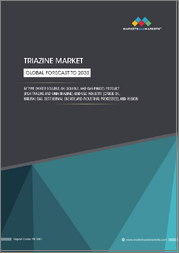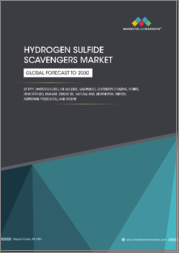
|
시장보고서
상품코드
1682780
세계의 트리아진(Triazine) 시장, 시장 규모와 점유율 분석 - 새로운 동향, 성장 기회, 경쟁 구도, 예측(2025-2032년)Triazine Market Size & Share Analysis - Emerging Trends, Growth Opportunities, Competitive Landscape, and Forecasts (2025 - 2032) |
||||||
세계 트리아진 시장 규모는 2024년 6억 6,988만 달러에서 2032년까지 10억 9,571만 달러에 달할 것으로 예상되며 6.46%의 연평균 복합 성장률(CAGR)을 보일 것으로 예측됩니다. 이 화합물은 석유 및 가스 산업, 특히 황화수소(H2S) 제거에 널리 사용되며, 의약품, 농업, 화학 제조에도 적용됩니다. 살충제, 제초제, 부식방지제 생산 등 트리아진의 다양한 용도가 시장 성장에 기여하고 있습니다. 또한, 석유화학 플랜트에서 효과적인 산 관리 화학 물질에 대한 수요 증가는 시장의 중요한 촉진요인으로 작용하고 있습니다.
중요한 고려사항
1,3,5-Triazine은 안정성과 화학, 석유 및 가스, 농약 생산에 광범위하게 사용되어 시장 점유율의 55%를 차지하는 가장 큰 카테고리입니다.
모노에탄올아민(MEA)은 석유 및 가스에서 H2S 포집제로 사용되기 때문에 여전히 주요 제품 카테고리입니다.
석유 및 가스 부문이 트리아진 시장을 독점하고 있으며, 35% 매출 점유율을 차지하고 있습니다.
1,2,4-Triazine은 의약품, 살충제, 농업에서의 소비 증가로 인해 가장 빠르게 성장하는 카테고리입니다.
농업 부문이 가장 높은 CAGR을 보일 것으로 예상되며, 트리아진은 밀과 옥수수와 같은 주요 작물의 제초제로 사용되고 있습니다.
세계 석유 소비 증가와 연료의 황 함량에 대한 규제 요건은 석유 및 가스 산업에서 트리아진에 대한 수요를 더욱 증가시키고 있습니다.
포름알데히드 배출에 대한 우려가 커지면서 특히 VOC가 인체 건강 위험으로 이어진다는 점에서 시장 성장에 도전이 되고 있습니다.
세계의 트리아진(Triazine) 시장에 대해 조사 분석했으며, 시장 역학, 지역별 시장 규모와 예측, 경쟁 구도 등의 정보를 전해드립니다.
목차
제1장 조사 배경
제2장 조사 방법
제3장 주요 요약
제4장 산업 전망
- 산업 전문가 소리/KOL
- 시장 부문 정의
- 유형별
- 1,3,5-트리아진
- 1,2,3-트리아진
- 1,2,4-트리아진
- 제품별
- 모노 에탄올 아민(MEA)
- 모노 메틸 아민(MMA)
- 기타
- 최종 용도별
- 의료
- 농업
- 화학
- 석유 및 가스
- 기타
- 유형별
- 밸류체인 분석
- 시장 역학
- 동향
- 인수합병(M&A) 증가
- 성장 촉진요인
- 성장 억제요인
- 동향
- 규제 분석
- 생산 공정 분석
- 세계 트리아진 시장에 대한 COVID-19의 영향
- 트리아진 시장에 대한 COVID-19의 영향
- Porter의 Five Forces 분석
제5장 세계 시장 규모와 예측
- 개요
- 유형별
- 제품별
- 최종 용도별
- 지역별
제6장 북미 시장 규모와 예측
- 개요
- 유형별
- 제품별
- 최종 용도별
- 국가별
제7장 유럽 시장 규모와 예측
- 개요
- 유형별
- 제품별
- 최종 용도별
- 국가별
제8장 아시아태평양 시장 규모와 예측
- 개요
- 유형별
- 제품별
- 최종 용도별
- 국가별
제9장 라틴아메리카 시장 규모와 예측
- 개요
- 유형별
- 제품별
- 최종 용도별
- 국가별
제10장 중동 및 아프리카 시장 규모와 예측
- 개요
- 유형별
- 제품별
- 최종 용도별
- 국가별
제11장 주요 시장
- 미국 시장
- 유형별
- 제품별
- 최종 용도별
- 독일 시장
- 유형별
- 제품별
- 최종 용도별
- 중국 시장
- 유형별
- 제품별
- 최종 용도별
- 브라질 시장
- 유형별
- 제품별
- 최종 용도별
- 사우디아라비아 시장
- 유형별
- 제품별
- 최종 용도별
제12장 경쟁 구도
- 기업과 제공 제품 리스트
- 주요 기업의 시장 점유율 분석
- 주요 기업 제품 벤치마킹
- 시장 전략적 발전
- 인수합병(M&A)
- 시설 확장
- 기타 발전
제13장 기업 개요
- Ashland Global Holdings Inc.
- Baker Hughes Company
- BASF SE
- Foremark Performance Chemicals
- Dow Inc.
- Eastman Chemical Company
- Evonik Industries AG
- Haihang Commercial Holding Co. Ltd.
- Hexion Inc.
- Stepan Company
제14장 부록
LSH 25.03.31The global triazine market is expected to grow from USD 669.88 million in 2024 to USD 1,095.71 million by 2032, at a CAGR of 6.46%. The compound is widely used in the oil and gas industry, particularly for hydrogen sulfide (H2S) scavenging, and also has applications in pharmaceuticals, agriculture, and chemical manufacturing. Triazine's diverse uses, such as in the production of pesticides, herbicides, and corrosion inhibitors, are contributing to its market growth. Moreover, increasing demand for effective sour management chemicals in petrochemical plants is a significant driver for the market.
Key Insights
The 1,3,5-triazine category is the largest, holding 55% of the market share, due to its stability and extensive use in chemicals, oil and gas, and pesticide production.
Monoethanolamine (MEA) remains the leading product category due to its use in oil and gas as an H2S scavenger.
The oil and gas sector dominates the triazine market, holding a 35% revenue share, with increasing exploration and production activities.
1,2,4-triazine is the fastest-growing category, driven by its rising consumption in pharmaceuticals, pesticides, and agriculture.
The agriculture sector is projected to witness the highest CAGR, with triazine used as a weed control agent in major crops like wheat and corn.
The rise in global oil consumption and regulatory requirements on sulfur content in fuels are further boosting the demand for triazine in the oil and gas industry.
The increasing concerns over formaldehyde emissions are posing a challenge to market growth, especially with VOCs linked to human health risks.
Table of Contents
Chapter 1. Research Background
- 1.1 Research Objectives
- 1.2 Market Definition
- 1.3 Research Scope
- 1.3.1 Market Segmentation by Type
- 1.3.2 Market Segmentation by Product
- 1.3.3 Market Segmentation by End Use
- 1.3.4 Market Segmentation by Region
- 1.4 Analysis Period
- 1.5 Market Data Reporting Unit
- 1.5.1 Volume
- 1.5.2 Value
- 1.6 Key Stakeholders
Chapter 2. Research Methodology
- 2.1 Secondary Research
- 2.1.1 Paid
- 2.1.2 Unpaid
- 2.1.3 P&S Intelligence Database
- 2.2 Primary Research
- 2.2.1 Breakdown of Primary Research Respondents
- 2.2.1.1 By region
- 2.2.2 By industry participant
- 2.2.3 By company type
- 2.2.1 Breakdown of Primary Research Respondents
- 2.3 Market Size Estimation
- 2.4 Data Triangulation
- 2.5 Currency Conversion Rates
- 2.6 Assumptions for the Study
Chapter 3. Executive Summary
Chapter 4. Industry Outlook
- 4.1 Voice of Industry Experts/ KOLs
- 4.2 Definition of Market Segments
- 4.2.1 By type
- 4.2.1.1 1,3,5-triazine
- 4.2.1.2 1,2,3-triazine
- 4.2.1.3 1,2,4-triazine
- 4.2.2 By Product
- 4.2.2.1 Monoethanolamine (MEA)
- 4.2.2.2 Monomethylamine (MMA)
- 4.2.2.3 Others
- 4.2.3 By End Use
- 4.2.3.1 Medical
- 4.2.3.2 Agriculture
- 4.2.3.3 Chemical
- 4.2.3.4 Oil & gas
- 4.2.3.5 Others
- 4.2.1 By type
- 4.3 Value Chain Analysis
- 4.4 Market Dynamics
- 4.4.1 Trends
- 4.4.1.1 Growing mergers and acquisitions
- 4.4.2 Drivers
- 4.4.2.1 Increasing application in petrochemical industry
- 4.4.2.2 Increasing application in medical industry
- 4.4.2.3 Increasing application in agrochemicals
- 4.4.2.4 Impact analysis of drivers on market forecast
- 4.4.3 Restraints
- 4.4.3.1 Increasing concerns about formaldehyde emissions
- 4.4.3.2 Impact analysis of restraints on market forecast
- 4.4.1 Trends
- 4.5 Regulation Analysis
- 4.6 Production Process Analysis
- 4.7 Impact of COVID-19 on Global Triazine Market
- 4.7.1 COVID-19 Impact on Triazine Market
- 4.8 Porter's Five Forces Analysis
- 4.8.1 Bargaining Power of Buyers
- 4.8.2 Bargaining Power of Suppliers
- 4.8.3 Intensity of Rivalry
- 4.8.4 Threat of New Entrants
- 4.8.5 Threat of Substitutes
Chapter 5. Global Market Size and Forecast
- 5.1 Overview
- 5.2 By Type
- 5.3 By Product
- 5.4 By End Use
- 5.5 By Region
Chapter 6. North America Market Size and Forecast
- 6.1 Overview
- 6.2 By Type
- 6.3 By Product
- 6.4 By End Use
- 6.5 By Country
Chapter 7. Europe Market Size and Forecast
- 7.1 Overview
- 7.2 By Type
- 7.3 By Product
- 7.4 By End Use
- 7.5 By Country
Chapter 8. APAC Market Size and Forecast
- 8.1 Overview
- 8.2 By Type
- 8.3 By Product
- 8.4 By End Use
- 8.5 By Country
Chapter 9. LATAM Market Size and Forecast
- 9.1 Overview
- 9.2 By Type
- 9.3 By Product
- 9.4 By End Use
- 9.5 By Country
Chapter 10. MEA Market Size and Forecast
- 10.1 Overview
- 10.2 By Type
- 10.3 By Product
- 10.4 By End Use
- 10.5 By Country
Chapter 11. Major Markets
- 11.1 U.S. Market
- 11.1.1 By Type
- 11.1.2 By Product
- 11.1.3 By End Use
- 11.2 Germany Market
- 11.2.1 By Type
- 11.2.2 By Product
- 11.2.3 By End Use
- 11.3 China Market
- 11.3.1 By Type
- 11.3.2 By Product
- 11.3.3 By End Use
- 11.4 Brazil Market
- 11.4.1 By Type
- 11.4.2 By Product
- 11.4.3 By End Use
- 11.5 Saudi Arabia Market
- 11.5.1 By Type
- 11.5.2 By Product
- 11.5.3 By End Use
Chapter 12. Competitive Landscape
- 12.1 List of Players and Their Offerings
- 12.2 Market Share Analysis of Key Players
- 12.3 Product Benchmarking of Key Players
- 12.4 Strategic Developments in the Market
- 12.4.1 Mergers and Acquisitions
- 12.4.2 Facility Expansions
- 12.4.3 Other Developments
Chapter 13. Company Profiles
- 13.1 Ashland Global Holdings Inc.
- 13.1.1 Business Overview
- 13.1.2 Product and Service Offerings
- 13.1.3 Key Financial Summary
- 13.2 Baker Hughes Company
- 13.2.1 Business Overview
- 13.2.2 Product and Service Offerings
- 13.2.3 Key Financial Summary
- 13.3 BASF SE
- 13.3.1 Business Overview
- 13.3.2 Product and Service Offerings
- 13.3.3 Key Financial Summary
- 13.4 Foremark Performance Chemicals
- 13.4.1 Business Overview
- 13.4.2 Product and Service Offerings
- 13.5 Dow Inc.
- 13.5.1 Business Overview
- 13.5.2 Product and Service Offerings
- 13.5.3 Key Financial Summary
- 13.6 Eastman Chemical Company
- 13.6.1 Business Overview
- 13.6.2 Product and Service Offerings
- 13.6.3 Key Financial Summary
- 13.7 Evonik Industries AG
- 13.7.1 Business Overview
- 13.7.2 Product and Service Offerings
- 13.7.3 Key Financial Summary
- 13.8 Haihang Commercial Holding Co. Ltd.
- 13.8.1 Business Overview
- 13.8.2 Product and Service Offerings
- 13.9 Hexion Inc.
- 13.9.1 Business Overview
- 13.9.2 Product and Service Offerings
- 13.10 Stepan Company
- 13.10.1 Business Overview
- 13.10.2 Product and Service Offerings
- 13.10.3 Key Financial Summary
Chapter 14. Appendix
- 14.1 Abbreviations
- 14.2 Sources and References
- 14.3 Related Reports



















